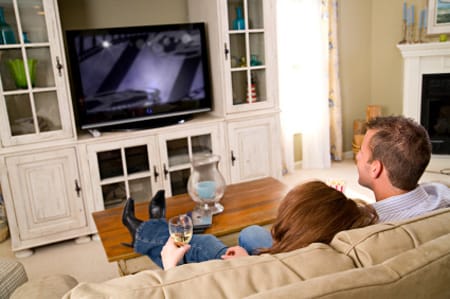Family television viewing will never be the same.
Winter hibernation in these parts used to involve having friends in for a card game. Enter the home theatre - all the fun, excitement and sound of the big screen in the comfort of your own home. Systems can range from a simple network you install yourself to a dedicated room designed and installed by the pros.
The first step should be to meet with a dealer and have a chat. Nick Gagne, in general sales for Glubes Audio Video Unlimited in Dartmouth, NS, says a detailed discussion of what the customer is looking for, how the home theatre will be used, whether it will be a system in the living room or be installed in a dedicated family or entertainment room, is essential. The average consumer needs to walk through all the options then take time to think things over and decide what works for his or her lifestyle, home and budget. A basic home theatre needs a screen or television for viewing, an audio system to enhance the sound and an upgrade to the existing cable or satellite subscription.
Gagne says most home theatres begin with a minimum 40-inch television screen, but they are available all the way up to 65-inch.
"Nowadays it's all flat panels, either plasma or LCD. The audio system is usually 5.1 which is effectively six speakers; five are called full range - a centre channel, two front speakers and two surround speakers. The .1 represents the subwoofer, which is a black box that gives you the base sounds like explosions, all the deep rumbles." Speakers range in size from something that will fit in the palm of your hand to six feet high. They can be visible or fitted into the ceiling or walls. So, whether you are building, renovating or creating a dedicated home theatre room, it is obviously wise to check out the home theatre equipment before the walls go up. Gagne says, "We do the whole nine yards - the initial design plan, working with architects or interior designers. We do the structured wiring before the drywall goes up. Then we come back to bring in all the equipment."
Some models also allow for a custom remote - so you press "watch television" and the TV, the cable box, and the sound system turn on with just one button. Ease of use is key.
A flat screen HD 1080p is the top of the line TV for home viewing. The flat screens replaced the heavy tube TVs a while back.
Daniel Panke, national manager for custom installs for Sony Style says, "The standard definition of the older tube televisions was 480 lines. High definition (HD) is anything that has more picture information and more lines of resolution."

Panke says people shouldn't worry that this format will change any time soon. "It took us 50 years to get to HD 1080p; it may take 10 to 15 years just to get HD 1080p as the norm in the market. Then we'll probably have 10 years on top of that when the industry will want to reap the rewards of having everybody on the same system."
Gagne says in order to view a program in HD you need three things: an HD television, a cable or satellite box capable of outputting HD, and HD service provided by your cable or satellite service. Eastlink or Bell Aliant would have to open the pipe as it were since HD, which is also a digital signal, is above what you are getting now with basic cable.
The program you want to view also has to be shot in high definition. Movies are, most national newscasts are, but not all programs or local news programs are in high definition yet. Gagne says you can still view programs on satellite or cable service using your HDTV without the HD service provided, but you won't get the high definition experience. High definition offers a much clearer, more vivid picture.
HD TVs come in plasma and LCD designs and, of course, there is significant debate over which is the superior technology. Gagne suggests plasma televisions will generally give you the best picture - better blacks and better greyscale to show more shades of colour, as well as handling motion better. Among existing technologies, plasma seems to have the picture edge.
Panke disagrees, "In today's market LCD is the clearer unit and dollar leader in flat panel TV sales, and the majority of clients have changed over to LCD due to clearer pictures, brighter images, easier set-up in normal room lighting conditions and far more energy efficiency. In equivalent moderate sizes (less than 50-inch) the LCD option is usually a higher resolution." He says plasma TVs use packages of phosphorus that have to light up to produce the picture so they draw a lot more electricity than an LCD.
The LCD, or liquid crystal display, is a really big microchip, similar to those used in computers. The screen is a huge array of little shutters that open and close to produce the picture. The faster the processor gets and the tighter the pixels get, the clearer the picture. (Pixels are picture elements; each pixel is a single point in a digital image. When you enlarge a digital photo you can often see the pixels, or little squares that make it up.)
When it comes to choosing speakers, Gagne says just to trust your ear. The foremost audio formats are Dolby True HD and DTS HD Master. Most Blu-ray discs are built around that quality. Blu-ray is the next step up in DVD technology. Where DVDs use a red laser to burn information to a disc and to read it, Blu-ray DVDs use a blue laser, which allows more information to be packed on a disc. "A conventional DVD will hold 8 gigabytes of information; a Blu-ray double-layer disc can hold 50 gigabytes. The more information, the better the picture and sound," says Panke. An added feature of Blu-ray discs, say a movie disc, is that it lets you go online through your computer, either by cable connection or wireless access, to download sites related to the movie or the star, interviews and such.
Panke says a good basic home theatre with a 5.1 sound system, HDTV 1080p, and a Blu-ray DVD would cost between $1,300 to $1,500. The cost would increase with a larger TV screen and more or better quality speakers. You may see retailer ads for a Home Theatre in a Box: these include everything you need except the TV. Some packages may also require additional cables and the cost of installation.
The ultimate home theatre has almost no limits. It can include a projector and 160-inch screen, as well as a large HDTV, Blu-ray DVD, speaker system installed in the ceiling or walls, a custombuilt room with non-parallel walls to enhance the acoustics, home theatre seating and lighting.
Welcome to winter hibernation in the 21st century.
